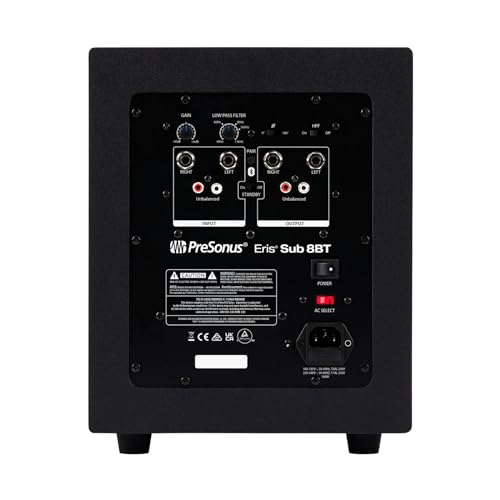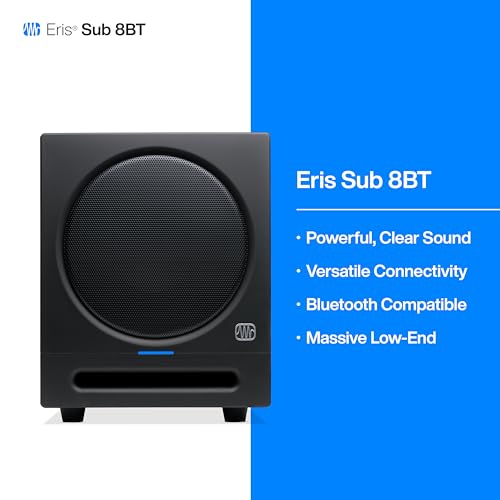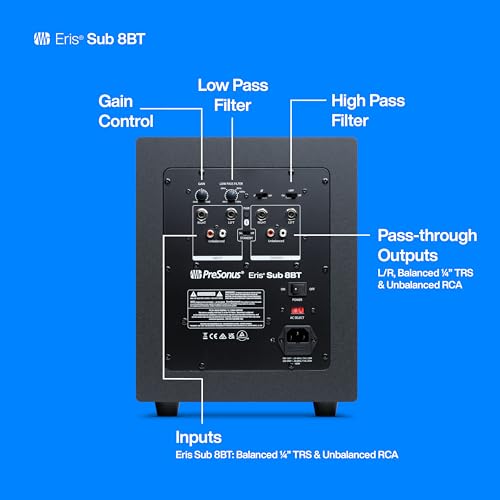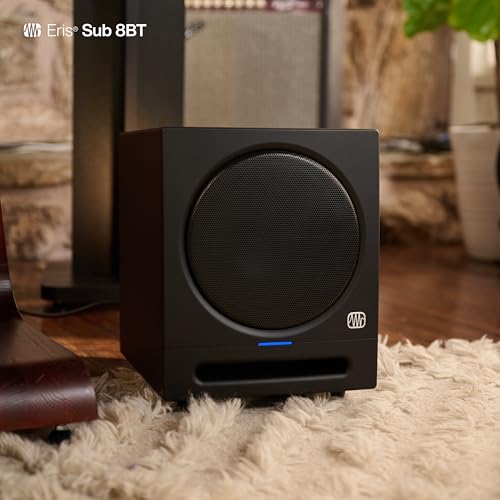The Foundation of Full-Range Sound:Technical Benchmark of the PreSonus Eris Sub 8BT
In the pursuit of truly immersive and accurate audio reproduction, no single component is more misunderstood, and more essential, than the subwoofer. The audible frequency spectrum is vast, and the laws of physics dictate that the reproduction of its lowest octaves—the visceral rumble of a cinematic explosion, the foundational note of a bass guitar, the deep pulse of electronic music—requires the movement of significant volumes of air. This is a task that most conventional bookshelf speakers or studio monitors, with their compact drivers, are simply not physically equipped to handle. Attempting to force these smaller speakers to produce deep bass results in distortion, compromised midrange clarity, and a generally inaccurate representation of the original audio. The dedicated subwoofer is the specialized engineering solution to this fundamental problem, designed for the sole purpose of handling the demanding low-frequency end of the spectrum.
However, the world of subwoofers is starkly divided. On one side are consumer-grade models, often designed to produce a singular, boomy “thump” that adds impact but sacrifices musicality and detail. On the other side are professional studio-grade subwoofers, engineered for absolute accuracy, tightness, and control, allowing sound engineers to make critical mixing decisions. The PreSonus Eris Sub 8BT emerges in 2025 as a remarkable and highly sought-after product precisely because it occupies the space between these two worlds. It is a compact, powered subwoofer that brings the precision, control, and honest sound reproduction of the recording studio into the home environment. With its versatile connectivity, including professional balanced inputs and the convenience of Bluetooth, and its critical crossover filtering capabilities, the Sub 8BT is designed not just to add bass, but to intelligently integrate with your main speakers to create a true, cohesive, full-range audio system.
This review will serve as an exhaustive technical benchmark of the PreSonus Eris Sub 8BT. We will move beyond subjective descriptions to perform a deep, analytical dive into the core technologies that define its performance. We will dissect the materials science of its woven-composite driver, analyze the power and efficiency of its 100-watt amplifier, and provide a detailed masterclass on its most crucial feature: the comprehensive crossover system that is the key to achieving seamless sonic integration. We will explore its myriad connection options and convenience features, from its balanced TRS inputs to its front-panel headphone amplifier. This is a forensic examination intended to reveal the engineering depth that makes the Eris Sub 8BT a definitive choice for music producers, audiophiles, gamers, and home theater enthusiasts, solidifying its position as a top-tier compact subwoofer in 2025.
Chapter 1: The Acoustic Core – An Analysis of Driver, Amplifier, and Cabinet Technology
The ability of the Eris Sub 8BT to produce deep, accurate, and impactful bass is not a result of chance, but of a carefully synergistic design that combines a high-quality driver, a purpose-built amplifier, and an acoustically optimized enclosure. Each component is engineered to work in concert to overcome the physical limitations inherent in a compact design.
The Science of “Tight” and “Expressive” Bass: The 8-inch Woven-Composite Woofer
The heart of any subwoofer is its driver, or woofer, and the material of its cone is a critical factor in its performance. PreSonus has opted for an 8-inch, front-firing woofer constructed from a woven-composite material. This choice is central to the subwoofer’s studio-heritage and its claim of producing “honest” and “accurate” sound. The ideal woofer cone possesses two competing physical properties: it must be incredibly rigid, yet also very lightweight.
- Rigidity: A rigid cone moves as a single, unified piston, even when subjected to the powerful forces of the voice coil. This prevents “cone breakup,” a form of distortion where different parts of the cone flex and move out of sync, resulting in a muddy, indistinct, and slow-sounding bass. Woven composite materials, such as glass fiber or aramid fiber, are exceptionally stiff for their mass, ensuring the driver accurately tracks the original audio signal. This is the key to achieving “tight” bass, where the start and stop of each bass note is clearly defined.
- Low Mass: A lighter cone can be accelerated and decelerated more quickly by the amplifier. This “transient response” is what allows the subwoofer to be “expressive,” reproducing the subtle textures and details in a bass guitar performance or the complex layers of a synthesized bassline, rather than just a one-note thud.
The “weave and nature” of this composite material provide superior damping compared to cheaper paper or polypropylene cones, which helps to control unwanted resonances. The result is a woofer that is fast, articulate, and capable of reproducing the nuances of low-frequency sound, which is essential for both critical music mixing and an immersive listening experience.

The Power Plant: The 100-Watt Onboard Amplifier
Moving a large 8-inch driver with the force required to produce deep bass requires significant power. The Eris Sub 8BT integrates a 100-watt amplifier directly into the cabinet. This “powered” or “active” design is highly efficient, as the amplifier is specifically chosen and tuned to match the exact electrical and physical characteristics of the driver it is paired with. This eliminates the guesswork and potential impedance mismatches of a passive subwoofer and separate amplifier setup.
The amplifier is most likely a Class D design. Class D amplifiers are the modern standard for powered subwoofers due to their incredible efficiency (often over 90%). This means that the vast majority of the electrical energy they draw is converted into power for the driver, with very little being wasted as heat. This is a critical consideration for an amplifier that is housed within a sealed, enclosed cabinet, ensuring reliable, cool operation even during demanding passages.
Engineering for True Extension: The 30 Hz Frequency Response
The Sub 8BT is rated down to a low-frequency extension of 30 Hz. To put this in perspective, the lowest note on a standard 4-string bass guitar is about 41 Hz. The ability to reproduce frequencies down to 30 Hz means the subwoofer can convey the sub-harmonic information that gives kick drums their visceral weight, that provides the foundational rumble in cinematic sound effects, and that is essential to many genres of electronic music. This deep extension is achieved through the careful tuning of the subwoofer’s cabinet and its front-firing bass reflex port. The port is an acoustically tuned tube that allows the air moved by the rear of the driver cone to exit the front of the enclosure. The dimensions of this port are precisely calculated to resonate at a specific low frequency, effectively reinforcing the driver’s output and allowing the system as a whole to play deeper and louder than a sealed enclosure of the same size ever could.
Chapter 2: The Art and Science of System Integration – Crossover and Tuning Controls
Perhaps the single most important and defining characteristic of a studio-quality subwoofer is not its power or depth, but its ability to be seamlessly integrated with a pair of main speakers. Simply adding a subwoofer to a system without proper management results in the “flabby, smudged, low-end mess” that PreSonus describes. The Eris Sub 8BT provides a comprehensive suite of controls, centered around its crossover network, that are essential for creating a cohesive and accurate full-range sound system.
The Crossover: The Key to a Cohesive Soundstage
A crossover is an electronic filter circuit that separates an audio signal into different frequency bands. The Sub 8BT includes two critical and independently operating crossover filters, which are the key to its professional performance.
- The Low-Pass Filter (LPF): This is the primary control for the subwoofer itself. The LPF is a variable filter (ranging from 50 Hz to 130 Hz) that tells the subwoofer: “Do not reproduce any frequencies **above** this set point.” The technical goal is to set the LPF to the precise frequency where your main studio monitors or bookshelf speakers begin to naturally lose their ability to produce bass (their “-3dB point” or “rolloff” frequency). For example, if you are using PreSonus Eris 3.5 monitors, which are effective down to about 80 Hz, you would set the Sub 8BT’s LPF control to 80 Hz. This ensures there is no significant overlap where both the subwoofer and the main speakers are trying to reproduce the same bass frequencies, which is the primary cause of boomy, undefined bass and phase cancellation issues.
- The High-Pass Filter (HPF): This is the feature that elevates the Sub 8BT from a consumer device to a true studio tool. The HPF is an 80 Hz filter that is applied to the main ¼-inch TRS outputs of the subwoofer. The correct way to integrate the sub in a professional setup is to run your audio source into the subwoofer’s inputs, and then run cables from the subwoofer’s outputs to your main speakers. When the HPF switch is engaged, the subwoofer intelligently strips out all the bass frequencies below 80 Hz from the signal *before* sending it to your main speakers. This has a profound effect on the overall system performance. It relieves the small woofers in your main monitors from the difficult and power-hungry task of trying to reproduce deep bass. This, in turn, reduces distortion in the monitors, increases their effective power handling (headroom), and results in a dramatically cleaner, more detailed, and less strained midrange. It allows the main speakers to do what they do best, and the subwoofer to do what it does best.
The correct implementation of these two filters is the absolute key to transforming two small speakers and a subwoofer into a single, accurate, and powerful full-range 2.1 monitoring system.

Precision-Tuning for Your Room
Beyond the critical crossover controls, the Sub 8BT provides additional tools for fine-tuning its performance to your specific room and speaker setup:
- Input Gain Control: This knob allows you to precisely match the volume level of the subwoofer to the output level of your main speakers. The goal is not to make the bass as loud as possible, but to make it sound like a natural extension of the main speakers, creating a seamless transition where you cannot tell where one stops and the other begins.
- Polarity Switch: This switch inverts the polarity of the subwoofer’s driver by 180 degrees. Due to room acoustics and speaker placement, the sound waves from the subwoofer and the main speakers can sometimes arrive at the listening position out of phase, causing them to partially cancel each other out at the crossover frequency, creating a noticeable “suck-out” or dip in the bass. Flipping the polarity switch can often correct this alignment issue, instantly restoring a solid and cohesive low end.
Chapter 3: The Universal Connectivity Hub
The Eris Sub 8BT is designed to be the central hub of a modern audio system, offering a comprehensive array of both wired and wireless connection options to accommodate virtually any audio source, from professional studio gear to everyday consumer devices.
Professional and Consumer Wired Inputs
The back panel of the Sub 8BT reveals its versatile nature:
- Balanced ¼-inch TRS Inputs: These are the professional standard for connecting audio devices. A balanced connection uses three conductors to transmit the audio signal, which allows it to cancel out any electronic noise or interference (like hum or buzz) that might be picked up along the length of the cable. This is the ideal way to connect the subwoofer to a professional audio interface, mixing console, or monitor controller for the cleanest possible signal path.
- Unbalanced RCA Inputs: These are the standard connection type for most consumer electronics. This allows for the easy connection of devices like a television, a stereo receiver, a CD player, or a turntable with a built-in phono preamp.
The inclusion of both professional and consumer input types means the Sub 8BT is equally at home in a recording studio as it is in a living room or home theater setup.

Modern Wireless Convenience: Bluetooth 5.0
Adding a layer of modern convenience is the built-in Bluetooth 5.0 receiver. This allows for easy, high-quality wireless audio streaming directly from a smartphone, tablet, or laptop. The use of the Bluetooth 5.0 standard ensures a more reliable and stable connection with better range and lower latency compared to older Bluetooth versions. This feature is incredibly practical for casual listening. It allows you to quickly turn your entire studio monitor system into a high-powered Bluetooth speaker for enjoying playlists or podcasts without needing to power on your computer or other wired sources.
User-Centric Front Panel Features
PreSonus has included several thoughtful features on the front panel for enhanced usability:
- ⅛-inch TRS Stereo Aux Input: This provides a quick and easy way to temporarily connect a portable audio source like a phone without having to access the rear panel connections.
- Built-in Headphone Amplifier: The front-panel headphone output is a brilliant workflow enhancement. Plugging a pair of headphones into this jack automatically mutes the output to the subwoofer and the main speakers connected to it. This allows a producer to quickly reference their mix on headphones to check for details, and then unplug to instantly hear it again on the full speaker system, all without needing a separate monitor controller.
Final Technical Analysis and Verdict

Pros: Key Engineering Strengths
- Studio-Grade Accuracy: The woven-composite driver and well-tuned enclosure deliver tight, articulate, and expressive bass that is ideal for critical listening and music production.
- Comprehensive Crossover Controls: The inclusion of both a variable low-pass filter and a switchable 80 Hz high-pass filter is a professional feature that allows for true, seamless system integration, dramatically improving the performance of the entire 2.1 system.
- Versatile Connectivity: A full suite of balanced TRS, unbalanced RCA, front-panel Aux, and Bluetooth 5.0 inputs makes it universally compatible with nearly any audio setup.
- Deep Frequency Extension: The ability to accurately reproduce frequencies down to 30 Hz is exceptional for a compact 8-inch subwoofer.
- Thoughtful Workflow Features: The front-panel headphone amplifier and aux input are incredibly practical additions that enhance day-to-day usability for producers and casual listeners alike.
Cons: Technical Limitations
- Fixed High-Pass Filter: While the 80 Hz high-pass filter is a standard and effective choice, a variable high-pass filter would have offered an even greater degree of system tuning flexibility.
- 100 Watts Power: While ample for small-to-medium rooms and near-field use, the 100-watt amplifier may not be sufficient for very large rooms or for users seeking extremely high sound pressure levels.
- No Phase Control Knob: While it includes a polarity switch, a variable phase control knob (found on more expensive subwoofers) would allow for even more precise time-alignment with main speakers.
Conclusion: The Definitive Compact Subwoofer for Prosumer Audio
After an exhaustive technical benchmark, the PreSonus Eris Sub 8BT proves itself to be an exceptionally well-engineered and intelligently designed product that punches far above its weight class. It is not merely a subwoofer that “adds bass”; it is a complete low-frequency management system that brings the precision and control of the recording studio to an accessible price point. Its true genius lies in its unwavering focus on the fundamentals of proper audio integration. The combination of its accurate woven-composite driver and, most importantly, its comprehensive crossover filtering system allows it to elevate the performance of an entire speaker setup, resulting in a cleaner, more detailed, and truly full-range listening experience.
The addition of a complete and versatile connectivity suite—from professional balanced inputs to the everyday convenience of Bluetooth—makes it a rare product that is perfectly suited for a multitude of applications. It is an ideal choice for the burgeoning music producer building their first studio, the discerning gamer seeking immersive audio, the cinephile creating a compact home theater, or the audiophile building a high-quality desktop system. For its remarkable blend of studio-grade accuracy, comprehensive control, and universal connectivity, the PreSonus Eris Sub 8BT stands as a definitive benchmark and a top-tier recommendation for anyone serious about achieving accurate, full-range sound in 2025.
See more posts in the category Speaker.
![PreSonus Eris Sub 8BT [2025] Technical Benchmark & Deep Dive Review](https://odvex.com/wp-content/uploads/2025/10/31fZivvRq3L-350x350.jpg)
![PreSonus Eris Sub 8BT [2025] Technical Benchmark & Deep Dive Review](https://odvex.com/wp-content/uploads/thumbs_dir/81QX4NBYo-L-rd8dxi78yf6yqt6phpoavdm68h6tc7eygdycigh930.jpg)
![PreSonus Eris Sub 8BT [2025] Technical Benchmark & Deep Dive Review](https://odvex.com/wp-content/uploads/thumbs_dir/31IIzGcnCZL-rd8ejziaeryuf2j57xi307e1p8duflnujnnepp5a9o.jpg)




